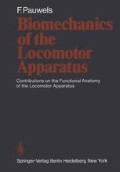Abstract
Grunewald (1920) asserted that bone is lighter because of its medullary cavity. His first argument is based on the fact that a tube requires less material than a solid rod of equal resistance to bending and of the same length. The diagram (Fig. 1 a-d) gives with figures the effect of the tubular construction on the amount of material required by a rod stressed in bending. The solid rod in Fig. 1 a and the three tubes in Fig. 1 b-d of different diameters and different wall thicknesses have the same length and the same resistance to bending. The weight of the solid rod, which would be 10 kg, can be reduced to 8,75, 6,68 or 4,28 kg if the construction is tubular. It can thus be decreased to less than half for the same resistance to bending and the same length.
Z. Anat. Entwickl. Gesch. 145, 81–85 (1974)
Access this chapter
Tax calculation will be finalised at checkout
Purchases are for personal use only
Preview
Unable to display preview. Download preview PDF.
References
Gebhardt, W.: Über die funktionelle Knochengestalt. Verh. dtsch. Ges. orthop. Chir. 27, (1910) 121–220.
Grunewald, J.: Die Beanspruchung der langen Röhrenknochen des Menschen. Z. orthop. Chir. 39, 129–147,257–286(1919).
Pauwels, F.: Gesammelte Abhandlungen zur funktionellen Anatomie des Bewegungsapparates. Berlin-Heidelberg-New York: Springer 1965.
Pauwels, F.: Atlas zur Biomechanik der gesunden und kranken Hüfte. Berlin-Heidelberg-New York: Springer 1973.
Pauwels, F.: Kurzer Überblick über die mechanische Beanspruchung des Knochens und ihre Bedeutung fur die funktionelle Anpassung. Z. Orthop. 111, 681–705 (1973).
Rauber, A.: Elastizität und Festigkeit der Knochen. Leipzig: Engelmann 1876.
Sieglbauer, F.: Lehrbuch der normalen Anatomie des Menschen. München, Berlin: Urban u. Schwarzenberg 1935.
Author information
Authors and Affiliations
Rights and permissions
Copyright information
© 1980 Springer-Verlag Berlin Heidelberg
About this chapter
Cite this chapter
Pauwels, F. (1980). The Significance of the Medullary Cavity for the Mechanical Stressing of the Tubular Bone. In: Biomechanics of the Locomotor Apparatus. Springer, Berlin, Heidelberg. https://doi.org/10.1007/978-3-642-67138-8_20
Download citation
DOI: https://doi.org/10.1007/978-3-642-67138-8_20
Publisher Name: Springer, Berlin, Heidelberg
Print ISBN: 978-3-642-67140-1
Online ISBN: 978-3-642-67138-8
eBook Packages: Springer Book Archive

